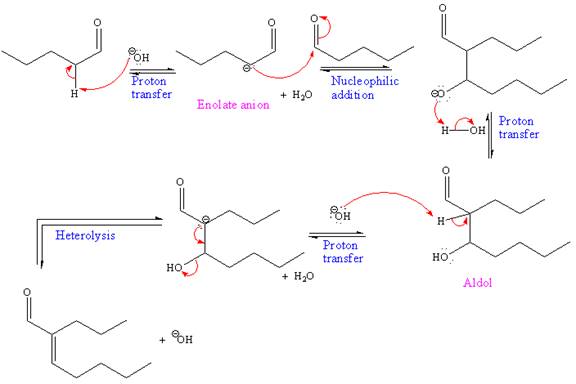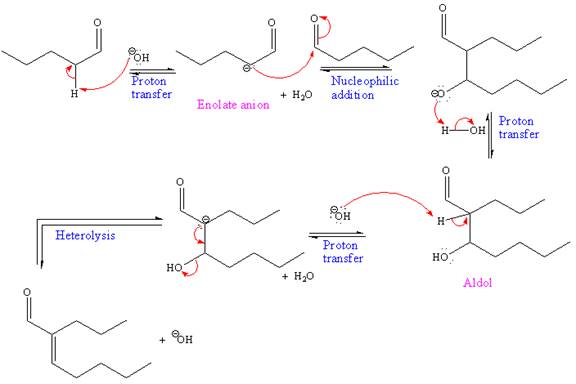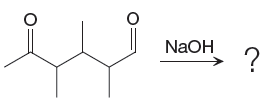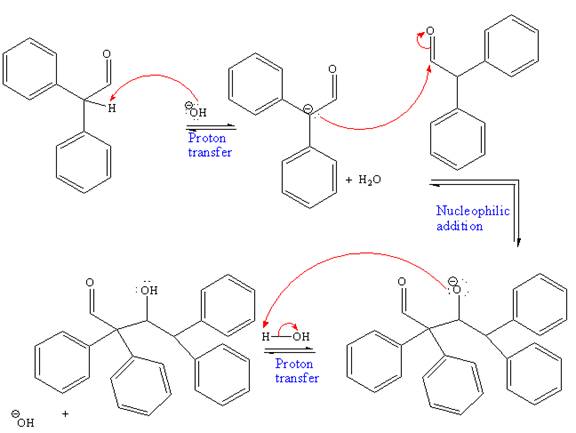
(a)
Interpretation:
The complete, detailed mechanism and the major organic product for the given reaction is to be drawn.
Concept introduction:
When an
Answer to Problem 18.65P
The complete, detailed mechanism and the major organic product for the given reaction are shown below:

Explanation of Solution
The given reaction is as shown below:

The given reaction is aldol condensation as the sodium hydroxide and heat is given. Firstly, the given aldehyde is treated with sodium hydroxide to produce
The complete, detailed mechanism and the major organic product for the given reaction are shown below:

The complete, detailed mechanism and the major organic product for the given reaction are drawn by aldol addition reaction, followed by E1cb mechanism.
(b)
Interpretation:
The complete, detailed mechanism and the major organic product for the given reaction are to be drawn.
Concept introduction:
When an aldehyde is treated with sodium hydroxide, the product
Answer to Problem 18.65P
The complete, detailed mechanism and the major organic product for the given reaction are as shown below:

Explanation of Solution
The given reaction is shown below:

The given reaction is aldol condensation as the sodium hydroxide and heat is given. Firstly, the given aldehyde is treated with sodium hydroxide to produce
The complete, detailed mechanism and the major organic product for the given reaction are shown below:

The complete, detailed mechanism and the major organic product for the given reaction are drawn by aldol addition reaction followed by E1cb mechanism.
(c)
Interpretation:
The complete, detailed mechanism and the major organic product for the given reaction is to be drawn.
Concept introduction:
When an aldehyde is treated with sodium hydroxide, the product
Answer to Problem 18.65P
The complete, detailed mechanism and the major organic product for the given reaction are as shown below:

Explanation of Solution
The given reaction is shown below:

The given reaction is aldol addition as the sodium hydroxide is given. The given aldehyde is treated with sodium hydroxide to produce
The complete, detailed mechanism and the major organic product for the given reaction are shown below:

The complete, detailed mechanism and the major organic product for the given reaction are drawn by intramolecular aldol addition reaction mechanism.
(d)
Interpretation:
The complete, detailed mechanism and the major organic product for the given reaction are to be drawn.
Concept introduction:
When aldehyde is treated with sodium hydroxide, the product
Answer to Problem 18.65P
The complete, detailed mechanism and the major organic product for the given reaction are as shown below:

Explanation of Solution
The given reaction is shown below:

The given reaction is aldol condensation as the sodium hydroxide and heat is given. Firstly, the given aldehyde is treated with sodium hydroxide, to produce
The complete, detailed mechanism and the major organic product for given reaction are shown below:

The complete, detailed mechanism and the major organic product for given reaction are drawn on the basis of aldol addition reaction mechanism.
Want to see more full solutions like this?
Chapter 18 Solutions
Organic Chemistry: Principles and Mechanisms (Second Edition)
- (12) Which one of the following statements about fluo- rometry is FALSE? a) Fluorescence is better detected at 90 from the exci- tation direction. b) Fluorescence is typically shifted to longer wave- length from the excitation wavelength. c) For most fluorescent compounds, radiation is pro- duced by a transitionarrow_forwardDon't used Ai solutionarrow_forwardDon't used Ai solutionarrow_forward
 ChemistryChemistryISBN:9781305957404Author:Steven S. Zumdahl, Susan A. Zumdahl, Donald J. DeCostePublisher:Cengage Learning
ChemistryChemistryISBN:9781305957404Author:Steven S. Zumdahl, Susan A. Zumdahl, Donald J. DeCostePublisher:Cengage Learning ChemistryChemistryISBN:9781259911156Author:Raymond Chang Dr., Jason Overby ProfessorPublisher:McGraw-Hill Education
ChemistryChemistryISBN:9781259911156Author:Raymond Chang Dr., Jason Overby ProfessorPublisher:McGraw-Hill Education Principles of Instrumental AnalysisChemistryISBN:9781305577213Author:Douglas A. Skoog, F. James Holler, Stanley R. CrouchPublisher:Cengage Learning
Principles of Instrumental AnalysisChemistryISBN:9781305577213Author:Douglas A. Skoog, F. James Holler, Stanley R. CrouchPublisher:Cengage Learning Organic ChemistryChemistryISBN:9780078021558Author:Janice Gorzynski Smith Dr.Publisher:McGraw-Hill Education
Organic ChemistryChemistryISBN:9780078021558Author:Janice Gorzynski Smith Dr.Publisher:McGraw-Hill Education Chemistry: Principles and ReactionsChemistryISBN:9781305079373Author:William L. Masterton, Cecile N. HurleyPublisher:Cengage Learning
Chemistry: Principles and ReactionsChemistryISBN:9781305079373Author:William L. Masterton, Cecile N. HurleyPublisher:Cengage Learning Elementary Principles of Chemical Processes, Bind...ChemistryISBN:9781118431221Author:Richard M. Felder, Ronald W. Rousseau, Lisa G. BullardPublisher:WILEY
Elementary Principles of Chemical Processes, Bind...ChemistryISBN:9781118431221Author:Richard M. Felder, Ronald W. Rousseau, Lisa G. BullardPublisher:WILEY





